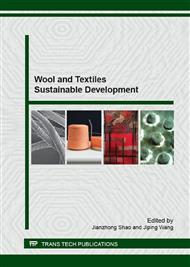[1]
Ojijo, V., et al., Nano-biocomposites based on synthetic aliphatic polyesters and nanoclay. Progress in Materials Science, 2014. pp.1-57.
DOI: 10.1016/j.pmatsci.2014.01.001
Google Scholar
[2]
Zhang, J., Moisture absorption finishing of polyester fabric.
Google Scholar
[3]
Ojstrsek, A., et al., Characterization of nano-sized TiO2 suspensions for functional modification of polyester fabric. Surface & Coatings Technology, 2013. pp.68-74.
DOI: 10.1016/j.surfcoat.2013.03.037
Google Scholar
[4]
Zhang, C.M., Surface modification of polyester fabrics for inkjet printing with atmospheric-pressure air/Ar plasma. Surface and Coatings Technology, 2009. 14: p.2058-(2063).
DOI: 10.1016/j.surfcoat.2009.02.006
Google Scholar
[5]
Nourbakhsh, S., et al., Comparison between laser application and atmospheric air plasma treatment on nanocellulose coating of polyester and nylon 66 fabrics. Journal of Laser Applications, 2005. 1.
DOI: 10.2351/1.4902832
Google Scholar
[6]
Wu, J.D., et al., Eco-friendly surface modification on polyester fabrics by esterase treatment. Applied Surface Science, 2014. 1: pp.150-157.
DOI: 10.1016/j.apsusc.2014.01.019
Google Scholar
[7]
Leeuwen, B.V., et al., Lactide-modified polyester resins with enhanced resin efficiency and improved coating performance. Surface and Coatings Technology, 2015. 1: pp.29-32.
Google Scholar
[8]
Raditoiu, A., et al., Polyester fibers coated with silica hybrid film forming materials containing non-ionic dyes. Journal of Optoelectronics and Advanceed Materials, 2015. 1-2: pp.198-204.
Google Scholar
[9]
Pan, L.L., et al., Enhanced mechanical and thermal properties of epoxy with hyperbranched polyester grafted perylene diimide. Rsc Adcances, 2015. 5: pp.3177-3186.
DOI: 10.1039/c4ra13609h
Google Scholar
[10]
Na, C. K., et al., Photo induced grafting of vinyl benzyl trimethyl ammonium chloride on polyester nonwoven fabric with surfactant coating and its anion-exchange properties. Journal of Applied Polymer Science, (2015).
DOI: 10.1002/app.41674
Google Scholar
[11]
Chen, J.J., et al., Synthesis and characterization of water-soluble chitosan grafted with hydrophilic aliphatic polyester. International Journal of Biological Macromolecules, 2015. pp.433-438.
DOI: 10.1016/j.ijbiomac.2015.01.001
Google Scholar
[12]
Zaman, M., et al., Hydrophilic modification of polyester fabric by applying nanocrystalline cellulose containing surface finish. Carbohydrate Polymers, 2013. 2: pp.560-567.
DOI: 10.1016/j.carbpol.2012.08.070
Google Scholar
[13]
Marzorati, M., et al., Incorporation of primary amines into a polyester chain by a combination of chemical and lipase-catalyzed epsilon-caprolactone ring-opening processes. Advanced Synthesis & Catalysis, 2007. 11-12: p.1963-(1968).
DOI: 10.1002/adsc.200600642
Google Scholar
[14]
Kale, K., et al., Atmospheric pressure glow discharge of helium-oxygen plasma treatment on polyester/cotton blended fabric. Indian Journal of Fiber & Textile Research, 2011. 2: 137-144.
Google Scholar
[15]
Medhat, M., et al., Effects of glow-discharge nitrogen-plasma on the linear birefringence of polyester sheets. Radiation Effects and Defects in Solids, 2011. 6: pp.417-426.
DOI: 10.1080/10420150.2011.566873
Google Scholar
[16]
Diaz-Benito, B., et al., Mechanical properties of polyester films painted after silanization of 6063 aluminium alloy with different pretreatment conditions. Progress in Organic Coatings, 2011. 4: pp.287-292.
DOI: 10.1016/j.porgcoat.2010.11.008
Google Scholar
[17]
Jocic, D., et al., Application of temperature and pH responsive microhydrogels for functional finishing of cotton fabric. Materials Technology, 2009. 1: pp.14-23.
DOI: 10.1179/175355509x417963
Google Scholar
[18]
Glampedaki, P., et al., Functional finishing of aminated polyester using biopolymer-based polyelectrolyte microgels. Biotechnology Journal, 2011. 10: pp.1219-1229.
DOI: 10.1002/biot.201100115
Google Scholar
[19]
Tourrette, A., et al., Incorporation of poly(N-isopropylacrylamide)/chitosan microgel onto plasma functionalized cotton fibre surface. Colloids and Surfaces A: Physicochemical and Engineering Aspects, 2009. 1–3: pp.126-135.
DOI: 10.1016/j.colsurfa.2009.10.014
Google Scholar
[20]
Kumar, T., et al., Modified chitosan hydrogels as drug delivery and tissue engineering systems: present status and applications. Acta Pharmaceutica Sinica B, 2012. 5: pp.439-449.
DOI: 10.1016/j.apsb.2012.07.004
Google Scholar
[21]
Lee, N.R., et al., In vitro evaluation of new functional properties of poly-γ-glutamic acid produced by Bacillus subtilis D7. Saudi Journal of Biological Sciences, 2014. 2: pp.153-158.
DOI: 10.1016/j.sjbs.2013.09.004
Google Scholar
[22]
Shih, I.L., et al., Microbial production of a poly(γ-glutamic acid) derivative by Bacillus subtilis. Process Biochemistry, 2005. 8: pp.2827-2832.
DOI: 10.1016/j.procbio.2004.12.009
Google Scholar
[23]
Bajaj, I., et al., Poly (glutamic acid) – An emerging biopolymer of commercial interest. Bioresource Technology. 2011. 10: pp.5551-5561.
DOI: 10.1016/j.biortech.2011.02.047
Google Scholar
[24]
Tsao, C.T., et al., Antibacterial activity and biocompatibility of a chitosan-gamma-poly(glutamic acid) polyelectrolyte complex hydrogel. Carbohydrate Research, 2010. 12: pp.1774-1780.
DOI: 10.1016/j.carres.2010.06.002
Google Scholar
[25]
Choi, S.H., et al., Preparation and swelling characteristics of hydrogel from microbial poly(gamma-glutamic acid) by gamma-irradiation. Macromolecular Research, 2005. 4: pp.339-343.
DOI: 10.1007/bf03218463
Google Scholar
[26]
Park, J.S., et al., Characteristics of Hydrogel Prepared from MicrobialPoly(γ-glutamic acid) by Chemical Crosslinker. Journal of Applied Biological Chemistry, 2005. 4: pp.213-217.
Google Scholar
[27]
Mustafa, E., et al., Antibacterial functionalization of cotton and polyester fabrics with a finishing agent based on silver-doped calcium phosphate powders. Textile Research Journal, 2012. 17: pp.1731-1742.
DOI: 10.1177/0040517512445331
Google Scholar
[28]
ISO TC, Textiles-Standard atmospheres for conditioning and testing, S. ISO 139-2005. ISO.
Google Scholar
[29]
Qingdao Fiber InspectionLTD Xiamen Xiang Heron Chemical Fiber Co. LTD Shandong Hailong Co. LTD Hangzhou Blue Peacock Chemical Fiber Co., Chemical fiber - moisture regain test method, S. GB/T 6503-(2008).
Google Scholar
[30]
Yan, J.J., et al., Preparation and Properties of Pullulan Composite Films.
Google Scholar
[31]
Dominique Dupuis, Textile processes: the importance of rheology. Mecanique & Industies, 2009. 1: pp.21-25.
Google Scholar
[32]
Boger, D.V., et al., Demonstration of upper and lower Newtonian fluid behaviour in a pseudoplastic fluid. Nature, 1977. 5590: pp.126-128.
DOI: 10.1038/265126a0
Google Scholar
[33]
Watanabe, K., et al., Drag reduction of Newtonian fluid in a circular pipe with a highly water-repellent wall. Journal of Fluid Mechanics, 1999. pp.225-238.
DOI: 10.1017/s0022112098003747
Google Scholar
[34]
Textile Industry Standardization InstituteTextile Industry Science And Center, Conventional moisture regains of textiles, S. GB 9994-2008. AQSIQ.
Google Scholar
[35]
Murakami, S., et al. Bio-based biodegradable hydrogels prepared by crosslinking of microbial poly(gamma-glutamic acid) with L-lysine in aqueous solution. Polymer Journal, 2011. 4: pp.414-420.
DOI: 10.1038/pj.2010.142
Google Scholar


